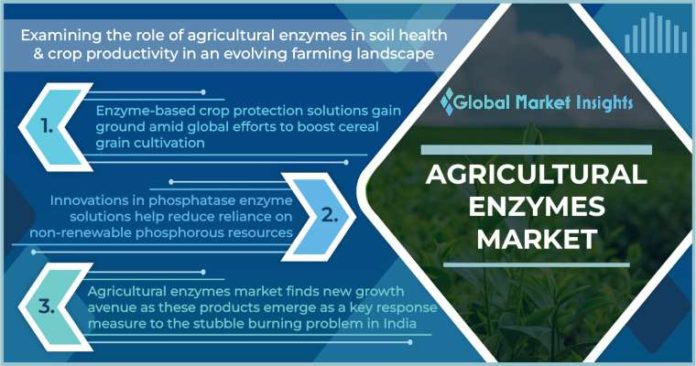As the significance of these essential proteins becomes increasingly apparent, agricultural operators and farmers are making targeted efforts to create a presence in the agricultural enzymes market, through the development of innovative enzyme blends for healthier soils in the years ahead.
Agricultural enzymes, in particular, are known to be common indicators of soil fertility and have gained immense traction over the years. Soil fertility and overall health are heavily dependent on optimum biological and chemical properties, such as nitrogen fixation, organic matter decomposition, detoxification of pesticides, and others, all of which can be facilitated by the use of enzymes in agriculture.
Enzyme-based crop protection solutions gain ground amid global efforts to boost cereal grain cultivation
All over the world, cereals and grains have historically held a strong position not just as a source of carbohydrates and energy, but also as one of the most integral sources of plant protein in the human diet. The significance of grain foods has become even more apparent in the current situation, where conflicts between Russia and Ukraine have had severe and wide-ranging impacts on food security and agricultural productivity. One of the main implications of the crisis has been the massive disruption to the production of grains like wheat since Ukraine and Russia are the foremost exporters of wheat.
In order to ensure that the countries dependent on these regions for grain foods have access to these crops at economical prices, a redirection of supply chains is a necessary step, which will require strong action from the U.S., the European Union, Australia, and others. Since agricultural enzymes play a key role in maintaining the production levels and quality of cereal and grain crops, creating enzyme-based crop protection solutions has become a major strategy for prominent agricultural enzymes market players, like Novozyme.
Innovations in phosphatase enzyme solutions help reduce reliance on non-renewable phosphorous resources
Nearly every organism, from animals to plants, in existence today depends on essential nutrients, especially phosphorous, for healthy development and growth. However, despite its significance in crop and plant cultivation, non-renewable phosphorous-based chemical fertilizers and products in agriculture are detrimental to crop yields and food chain sustainability in the long run.
While agriculture has been among the largest consumers of non-renewable phosphorous, the limited supply of these resources has created an insurmountable challenge in terms of biodiversity, climate regulation, and food security. In order to address these issues, several efforts are underway to explore options that facilitate the seamless availability of phosphorous to plants. This is majorly impacting agricultural enzymes industry growth as phosphatases are becoming an area of interest in this regard.
To illustrate, in April 2022, researchers from the University of Sheffield’s Institute for Sustainable Food discovered PafA, a unique bacterial phosphatase enzyme abundant, in the environment, which demonstrates the ability to release fertilizer-based phosphate from its organic forms. The identification of this enzyme is a potential solution for the current concerns associated with the excessive use of phosphate chemical fertilizers produced through the mining of non-renewable and expensive rock phosphate sources.
The agricultural enzymes market will benefit substantially from such R&D initiatives. Since PafA has been found to occur significantly in the environment, both in aquatic as well as land environments, it is coming to be considered a valuable resource for animal and plant nutrition. Simultaneously, it also reduced dependence on the limited stocks of non-renewable phosphate-based fertilizers.
Agricultural enzymes market finds new growth avenue as these products emerge as a key response measure to the stubble burning problem in India
By far, one of the most severe challenges plaguing the modern agricultural sector worldwide is stubble burning. This problem is especially prevalent in India, which is known as the largest rice exporter globally. According to SAFAR (System of Air Quality and Weather Forecasting and Research), crop-burning practices are responsible for over 45% of the air pollution problem in the capital city of Delhi. In 2021 alone, over 70,000 farm fires were identified through satellite imagery from the ESA (European Space Agency)
Over the years, stubble burning has emerged as a perennial issue, driven mainly by policy mismatches, faulty agricultural practices, and a dearth of alternative options available to farmers.
Source:








